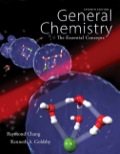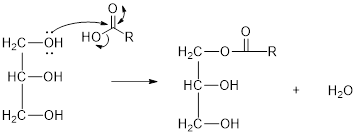
Concept explainers
a)
Interpretation:
A reaction that leads to the formation of triglyceride, starting with glycerol and carboxylic acids has to be suggested.
Concept introduction:
Ester formation reaction: Reaction of alcohol and

a)
Explanation of Solution
The hydroxyl group act as nucleophile and the carboxylic group act as electrophile in presence of acid catalyst; the nucleophile attack at electrophilic carbon of carboxylic acid leads to the formation of ester with the elimination of water molecule.
Mechanism of condensation reaction:



As shown above, the successive steps lead to the formation of triglycerides containing three ester group with the elimination of three water molecules.
b)
Interpretation:
An equation for the base hydrolysis of ester has to be written.
Concept introduction:
Ester formation reaction: Reaction of alcohol and carboxylic acid using acid catalyst results the ester formation with the elimination of water molecule.

b)
Explanation of Solution
The hydroxyl group acts as nucleophile and the carbonyl carbon act as electrophile; the nucleophile attack at electrophilic carbon of ester leads to the formation of alcohol with the elimination of fatty acid salts (soap).
Base hydrolysis of Esters:

c)
Interpretation:
Difference between fats and oils has to be explained.
Concept introduction:
Melting point: At temperature begins the solid to melt.
Unsaturation bonds: The presence of double or triple bonds in the molecules.
c)
Explanation of Solution
The presence of unsaturated bonds in the molecules tight close packing will be less due to bend of double bonds and the intermolecular attraction between them is less and less energy is required to overcome the interaction. More the double bonds lower the intermolecular interaction. Hence, the melting point decreases.
d)
Interpretation:
Reagent and catalyst used in hydrogenation process has to be identified.
Concept introduction:
Hydrogenation of
Homogeneous catalyst: Catalyst used is in same phase as the reactants.
Heterogeneous catalyst: Catalyst used is in different phase as the reactants.
d)
Explanation of Solution
Liquid oil is obtained from plants, having double bonds the presence of reactive double bond is converted into single bonds in order to solidify. Hydrogenation of double bonds is the process in which hydrogen molecule is added across the double bond forming alkane product. The alkane is highly facilitated for close packing and solidifies the oil.
Reaction carried out is hydrogenation reaction; hydrogen molecule is the reagent used in presence of either heterogeneous or homogeneous catalyst.
e)
Interpretation:
Iodine number has to be calculated.
Concept introduction:
Iodine number: number of grams of Iodine that react with given quantity of oil is called Iodine number.
Number of moles = Molarity
e)
Explanation of Solution
Given: molarity of
Number of moles of
The mol ratio between
Number of grams of
The iodine number is the number of grams of iodine that reacts with 100 g of corn oil.
Hence, Iodine number calculated is 123
Want to see more full solutions like this?
Chapter 11 Solutions
EBK GENERAL CHEMISTRY: THE ESSENTIAL CO
- Draw the Haworth projection of the disaccharide made by joining D-glucose and D-mannose with a ẞ(1-4) glycosidic bond. If the disaccharide has more than one anomer, you can draw any of them. Click and drag to start drawing a structure. Xarrow_forwardEpoxides can be opened in aqueous acid or aqueous base to produce diols (molecules with two OH groups). In this question, you'll explore the mechanism of epoxide opening in aqueous acid. 2nd attempt Be sure to show all four bonds at stereocenters using hash and wedge lines. 0 0 Draw curved arrows to show how the epoxide reacts with hydronium ion. 100 +1: 1st attempt Feedback Be sure to show all four bonds at stereocenters using hash and wedge lines. See Periodic Table See Hint H A 5 F F Hr See Periodic Table See Hintarrow_forward03 Question (1 point) For the reaction below, draw both of the major organic products. Be sure to consider stereochemistry. > 1. CH₂CH₂MgBr 2. H₂O 3rd attempt Draw all four bonds at chiral centers. Draw all stereoisomers formed. Draw the structures here. e 130 AN H See Periodic Table See Hint P C Brarrow_forward
- You may wish to address the following issues in your response if they are pertinent to the reaction(s) you propose to employ:1) Chemoselectivity (why this functional group and not another?) 2) Regioselectivity (why here and not there?) 3) Stereoselectivity (why this stereoisomer?) 4) Changes in oxidation state. Please make it in detail and draw it out too in what step what happens. Thank you for helping me!arrow_forward1) Chemoselectivity (why this functional group and not another?) 2) Regioselectivity (why here and not there?) 3) Stereoselectivity (why this stereoisomer?) 4) Changes in oxidation state. Everything in detail and draw out and write it.arrow_forwardCalculating the pH at equivalence of a titration 3/5 Izabella A chemist titrates 120.0 mL of a 0.7191M dimethylamine ((CH3)2NH) solution with 0.5501 M HBr solution at 25 °C. Calculate the pH at equivalence. The pk of dimethylamine is 3.27. Round your answer to 2 decimal places. Note for advanced students: you may assume the total volume of the solution equals the initial volume plus the volume of HBr solution added. pH = ☐ ✓ 18 Ar Boarrow_forward
- Alcohols can be synthesized using an acid-catalyzed hydration of an alkene. An alkene is combined with aqueous acid (e.. sulfuric acid in water). The reaction mechanism typically involves a carbocation intermediate. > 3rd attempt 3343 10 8 Draw arrows to show the reaction between the alkene and hydronium ion. that 2nd attempt Feedback 1st attempt تعمال Ju See Periodic Table See Hint F D Ju See Periodic Table See Hintarrow_forwardDraw the simplified curved arrow mechanism for the reaction of acetone and CHgLi to give the major product. 4th attempt Π Draw the simplified curved arrow mechanism T 3rd attempt Feedback Ju See Periodic Table See Hint H -H H -I H F See Periodic Table See Hintarrow_forwardSelect the correct reagent to accomplish the first step of this reaction. Then draw a mechanism on the Grignard reagent using curved arrow notation to show how it is converted to the final product. 4th attempt Part 1 (0.5 point) Select the correct reagent to accomplish the first step of this reaction. Choose one: OA Mg in ethanol (EtOH) OB. 2 Li in THF O C. Li in THF D. Mg in THF O E Mg in H2O Part 2 (0.5 point) Br Part 1 Bri Mg CH B CH, 1 Draw intermediate here, but no arrows. © TE See Periodic Table See Hint See Hint ין Harrow_forward
- Select the product for the following reaction. HO HO PCC OH ○ OH O HO ○ HO HO HOarrow_forward5:45 Х Select the final product for the following reaction sequence. O O 1. Mg. ether 2.D.Oarrow_forwardBased on the chart Two similarities between the molecule with alpha glycosidic linkages. Two similarities between the molecules with beta glycosidtic linkages. Two differences between the alpha and beta glycosidic linkages.arrow_forward
 ChemistryChemistryISBN:9781305957404Author:Steven S. Zumdahl, Susan A. Zumdahl, Donald J. DeCostePublisher:Cengage Learning
ChemistryChemistryISBN:9781305957404Author:Steven S. Zumdahl, Susan A. Zumdahl, Donald J. DeCostePublisher:Cengage Learning ChemistryChemistryISBN:9781259911156Author:Raymond Chang Dr., Jason Overby ProfessorPublisher:McGraw-Hill Education
ChemistryChemistryISBN:9781259911156Author:Raymond Chang Dr., Jason Overby ProfessorPublisher:McGraw-Hill Education Principles of Instrumental AnalysisChemistryISBN:9781305577213Author:Douglas A. Skoog, F. James Holler, Stanley R. CrouchPublisher:Cengage Learning
Principles of Instrumental AnalysisChemistryISBN:9781305577213Author:Douglas A. Skoog, F. James Holler, Stanley R. CrouchPublisher:Cengage Learning Organic ChemistryChemistryISBN:9780078021558Author:Janice Gorzynski Smith Dr.Publisher:McGraw-Hill Education
Organic ChemistryChemistryISBN:9780078021558Author:Janice Gorzynski Smith Dr.Publisher:McGraw-Hill Education Chemistry: Principles and ReactionsChemistryISBN:9781305079373Author:William L. Masterton, Cecile N. HurleyPublisher:Cengage Learning
Chemistry: Principles and ReactionsChemistryISBN:9781305079373Author:William L. Masterton, Cecile N. HurleyPublisher:Cengage Learning Elementary Principles of Chemical Processes, Bind...ChemistryISBN:9781118431221Author:Richard M. Felder, Ronald W. Rousseau, Lisa G. BullardPublisher:WILEY
Elementary Principles of Chemical Processes, Bind...ChemistryISBN:9781118431221Author:Richard M. Felder, Ronald W. Rousseau, Lisa G. BullardPublisher:WILEY





